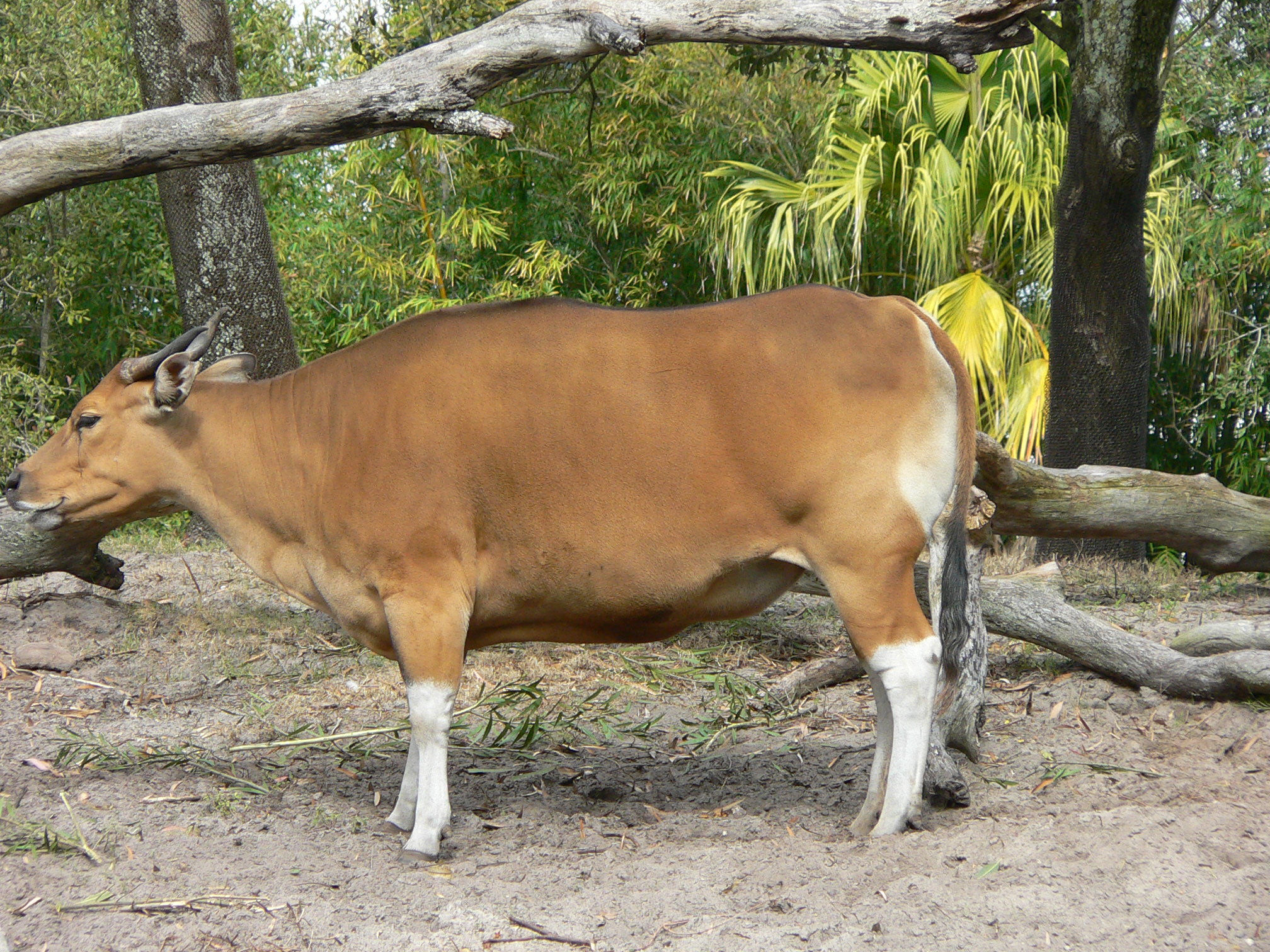- Bos
image_width = 250px
image_caption =Banteng ("Bos javanicus ")
regnum =Animal ia
phylum = Chordata
classis =Mammal
ordo =Artiodactyla
familia =Bovidae
subfamilia =Bovinae
genus = "Bos"
genus_authority = Linnaeus, 1758
subdivision_ranks =Species
subdivision ="B. acutifrons" †
"B. aegyptiacus" †
"B. frontalis"
"B. gaurus"
"B. grunniens"
"B. javanicus"
"B. planifrons" †
"B. primigenius" †
"B. sauveli"
"B. taurus""Bos" is the
genus of wild and domesticcattle . "Bos" can be divided into four subgenera: "Bos", "Bibos", "Novibos", and "Poephagus", but the distinction is controversial. The genus has five extant species. However, this may rise to seven if thedomesticated varieties are counted as separate species.Anatomy and morphology
Most species are grazers, with long tongues to twist the plant material they favor and large teeth to break up the plant material they ingest. Many species are
ruminant , having a four-chambered stomach that allows them to break down the tough plant material they consume.Range and distribution
There are about 1.3 billion domestic cattle alive today, making them one of the world's most numerous mammals. Members of this genus are currently found in Africa, Asia, eastern Europe and North America. Their habitats vary greatly depending on the particular species; they can be found in prairies, rain forests, wetlands, savannas and temperate forests.
Ecology, behavior and life history
"Bos" have a lifespan of 18-25 years in the wild, with up to 36 being recorded in captivity. They have a 9-11 month
gestation , depending on the species and birth one, or rarely two young in the spring.Most species travel in herds ranging in size from 10 members into the hundreds. Within most herds, there is one bull (male) for all the
cow s (female). Dominance is important in the herds; calves will usually inherit their mothers spot in thehierarchy .They are generally diurnal, resting in the hot part of the day and being active morning and afternoon. In areas where humans have encroached on the territory of a herd, they may turn
nocturnal . Some species are also migratory, moving with food and water availability.Evolutionary history
Modern species of "Bos" are thought to have evolved from a single ancestor, the
aurochs ("B. primigenius"). This particular species survived until the 1600s when it was hunted toextinct ion.Systematics and taxonomy
* Subgenus "Bos"
** "Bos primigenius " (aurochs ) †
** "Bos taurus " (cattle andzebu , domesticated form of "Bos primigenius")
** "Bos aegyptiacus " (Egypt ian cattle; name not recognized by ITIS) †
** "Bos acutifrons " †
** "Bos planifrons " †
* Subgenus "Bibos"
** "Bos gaurus " (gaur or Indian bison)
** "Bos frontalis " (gayal or mithun, domesticated form of "Bos gaurus")
** "Bos javanicus " (banteng)
* "Subgenus Novibos"
** "Bos sauveli" (kouprey or Grey ox)
* Subgenus "Poephagus"
** "Bos grunniens " (yak ; also "Bos mutus")In 2003, the
International Commission on Zoological Nomenclature resolved a long-standing dispute about the naming of those species (or pairs of species) of "Bos" that contain both wild and domesticated forms. The commission "conserved the usage of 17 specific names based on wild species, which are pre-dated by or contemporary with those based on domestic forms", confirming "Bos primigenius" for the aurochs and "Bos gaurus" for the gaur. If domesticated cattle and gayal are considered separate species, they are to be named "Bos taurus" and "Bos frontalis"; however, if they are considered part of the same species as their wild relatives, the common species are to be named "Bos primigenius" and "Bos gaurus".Bibliography
* Briggs, H.M. and Briggs, D.M. (1980). "Modern Breeds of Livestock". Macmillan Publishing.
* International Commission on Zoological Nomenclature. 2003. Opinion 2027 (Case 3010). Usage of 17 specific names based on wild species which are pre-dated by or contemporary with those based on domestic animals (Lepidoptera, Osteichthyes, Mammalia): conserved. Bull.Zool.Nomencl., 60:81-84.
* Van Vuure, Cis. 2003. De Oeros – Het spoor terug, Cis van Vuure, Wageningen University and Research Centrum / Ministry of the Flemish Community, Brussels & Wageningen.
* Zong, G. 1984. A record of Bos primigenius from the Quaternary of the Aba Tibetan Autonomous Region. Vertebrata PalAsiatica, Volume XXII No. 3 pp. 239-245. Translated by Jeremy Dehut, April 1991. [http://www.nau.edu/~qsp/will_downs/79.Bos.pdf Online pdf (62 kB)]References
External links
* Vasey, George 1862. A monograph of the genus "Bos". [http://www.archive.org/details/amonographofgenu00vaseiala Scan of a historic work]
Wikimedia Foundation. 2010.

